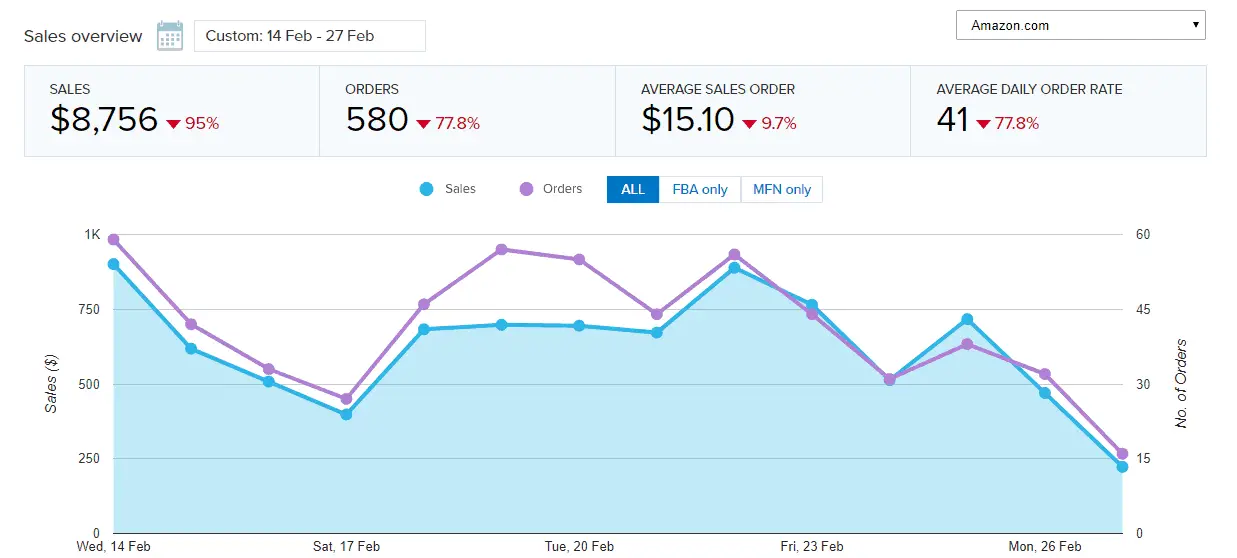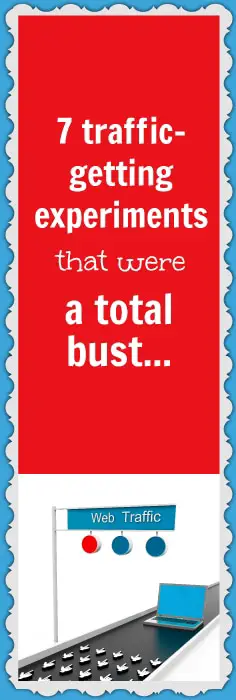When it comes to marketing, there’s a lot of trial and error. What works well for one person or brand may be a complete flop for someone else.
Having a lot of failures under your belt is a GOOD thing though. It means you’re trying. Even geniuses like Einstein and Picasso had a pretty small success rate compared to all the things they tried.
And in the vein of failing, today’s post is all about some case studies and experiments we’ve tried over the past few months that ended up becoming complete busts.
You can either learn from our experiences, or maybe you’ll read one of these case studies and come up with a way to make it work. If you do, let me know!
And until then, let’s take a look at the strategies we tried and what went wrong…
Failed experiment #1: Case study using Repricer Express
The premise:
We wanted to test-drive the Repricer Express tool as a way of helping people monitor their competitors’ prices so they could offer the best possible rates on Amazon.
What we did:
From Michaela:
I signed up for the 15-day free trial and decided to test a mix of products, including some that sell well, some that sell just okay, and some that don’t get many sales at all, so I could get a well-rounded perspective.
I linked my Amazon US Marketplace account to the service by inputting Repricer Express along with its account number into my Amazon Marketplace Web Service.
Amazon then generated a stock report and I was able to create the following repricing rule: “compete with all sellers and beat the lowest price by 1p or 1cent.”
Next, I created minimums/maximums to set floor and ceiling limits on my products’ prices. Then, I jump-started repricing in “safe mode.”
After, I was able to see repricing activity on my Repricer Express dashboard within an hour.
The outcome:
As you can see below, my sales counts actually decreased after my 15-day free trial with Repricer Express.
Reflections:
Given the decline in my sales rate, I don’t think this service is worth investing in or recommending.
However, if you wanted to give the trial a whirl yourself, it wasn’t all that time consuming to get set up and it won’t cost you anything. I just wouldn’t have high hopes of getting positive results.
Failed experiment #2: Case study using Storewoot
The premise:
We were curious about trying out some Etsy apps and I came across Storewoot, which helps you drive traffic and sales to your Etsy store by promoting your products on Pinterest.
What we did:
From Michaela:
Storewoot gives you one free credit to start, but I ended up purchasing 20 additional credits at $2 a piece. Promotions last for 30 days, and you get to promote one Etsy product with each credit. So, in total, I ran promotions for 21 different Etsy products.
With my free credit, I chose one of my Etsy products at random. But with the additional 20 credits I purchased, I chose products that hadn’t been selling well so I could get a good sense of how effective Storewoot was at driving traffic and increasing sales.
The outcome:
With the 20 products I promoted with the 20 credits I purchased, not a single sale was made, nor was a significant amount of traffic driven to my Etsy store from Pinterest.
With the product I promoted with my 1 free credit, however, quite a few sales did end up coming in. I just can’t necessarily attribute these sales to Storewoot because that particular design was one that made a really good gift for someone’s boyfriend, and the time that this promotion ran was just a few weeks before Valentine’s Day. So I think the mug’s selling success had more to do with timing than it did Storewoot.
Reflections:
I ran into a ton of logistical issues while using this app. And Storewoot’s customer support was pretty useless. I waited days to get a response after following up multiple times, and in some cases, I never got a reply.
So considering I paid $40 to use this app and my overall results were pretty lackluster, I wouldn’t recommend using Storewoot.
Failed experiment #3: Posting product videos to Pinterest
The premise:
I read an article about how posting product videos to Pinterest can be a traffic-booster so I wanted to give it a try and see for myself.
What we did:
From Michaela:
I chose 5 mug designs that hadn’t sold well in my Etsy shop and had a Fiverr person create a quick video about each product, also including a BUY NOW link at the end. Then, I posted the 5 videos to Pinterest along with 5-8 relevant hashtags and waited a few weeks to see if any sales came in from Pinterest.
The outcome:
Unfortunately, my Pinterest product videos didn’t generate any new sales or drive any significant traffic to my Etsy store.
Reflections:
Like many marketing strategies, creating product videos for Pinterest could potentially work better for other niches. So just because I didn’t have any success with my dog-related product videos, that doesn’t necessarily mean the strategy wouldn’t work well for other types of designs.
But since I did have to spend money to get the videos created and didn’t get any sales in return, this technique is a bust in my eyes.
Failed experiment #4: Ranking YouTube videos on Google
The premise:
I came across a guide about YouTube SEO that I wanted to test to see if I could rank one or more of my product videos on Google’s first page.
What we did:
While my product videos hadn’t produced any results from Pinterest, I wasn’t ready to cut my losses without at least trying out one more technique.
So I took those same 5 product videos and posted them on YouTube. Next, I followed all of the applicable suggestions laid out in the guide I mentioned, including…
- keyword research
- optimizing the video file names by including keywords
- adding keywords to the uploaded video titles and descriptions
- finding tags to use by looking at the source code of competitors’ videos
- creating playlists
Then, I waited to see if any movement happened with my videos’ Google rankings.
The outcome:
After a few weeks, no significant changes took place, and none of my videos ever made it to Google’s first page.
Reflections:
I can’t say the quality of these videos was fantastic. It was a matter of them being “good enough” and getting what you pay for.
But that being said, the videos got barely any views after following the SEO suggestions, although — again — trying a different niche could possibly yield different results. However, since these videos already flopped on Pinterest, I feel ready to call it quits with them after they flopped on YouTube as well.
Failed experiment #5: Submitting press releases
The premise:
The idea here was to create a press release for one of my new mug designs and then see what kind of traction it might produce.
What we did:
I made a list of places to submit a press release that were good for promoting new designs and ecommerce stores. Then, I created a press release about one of my stores and a personalized mug that recently became available and submitted it to all of the press release sites.
The outcome:
My press release was accepted by all of the sites except for one that said the content was too “promotional.” None of my other accepted press releases resulted in any new sales for the personalized mug, however.
Reflections:
I was skeptical about this idea from the start, as I’ve tried submitting press releases in the past and they’ve always been a bust. But I thought I’d give it another shot to see if I might get better results this time around.
Unfortunately, though, I did not. And given the amount of time and energy it takes to write a press release, I wouldn’t recommend even attempting this strategy to see if you might experience a different outcome.
Failed experiment #6: Case study creating monthly mug subscriptions
The premise:
I wanted to try the UseGearBubble feature that lets you create monthly mug subscriptions and then reach out to niche influencers to see if they’d like a free sample in exchange for posting about the subscription offer via social media.
What we did:
I actually tried this strategy in two niches, one related to dogs and the other related to feminism. Inside UseGearBubble, I created two monthly mug subscription offers, selling each mug for $12.95.
Next, I reached out to close to 200 niche influencers (people with sizable followings) via Facebook, Twitter, Pinterest, and related blogs, asking people if they’d like to receive a free mug in exchange for posting about the subscription offer on their social media profiles or blog.
To everyone who responded affirmatively, I sent a free mug. The, I followed up about a week or so later to see if they’d received and liked the mug, and if so, I gave them the link to the subscription offer again so they could post it on their blogs or via social media.
The outcome:
I had high hopes for this strategy, as partnering with niche influencers has produced good results for me in the past — but not this time.
Of the people I reached out to, I got the best response rate from bloggers for the feminist subscription offer. Virtually no one I contacted via Facebook, Twitter, or Pinterest — for either offer — responded, and I received barely any responses, in general, for the dog-related subscription offer.
In total, I got 22 affirmative responses and I ended up sending out 18 free mugs.
Of those 18 mug recipients, 10 got back to me about posting to social media or on their blogs.
But even though these bloggers all created positive posts about my subscription offer, including links, tags, photos, and even a couple un-boxing videos, no sales came in for either of my monthly mug subscription offers.
Reflections:
While this could possibly work better for other niches, I have a feeling monthly mug subscriptions might work better as an upsell versus a front-end offer.
There could have been an issue with the $12.95 price-point, too. Pricing each mug a little lower might possibly yield better results, although, at this point, I feel I’ve spent enough time on this and sent out enough free mugs to decide it’s time to move on.
Failed experiment #7: Product roundup case study
The premise:
For this strategy, I wanted to pick a theme, choose several related Etsy products, and compile them into a list along with an accompanying graphic that I would then encourage other Etsy shop owners to promote.
What we did:
After deciding on the theme “Gift ideas for pit bull lovers,” I chose 3 products from my Etsy shop. Then, I found 7 complementary products from 7 different Etsy shops, each of which had a lot of positive reviews.
Next, I had one of my designers create a graphic with all of the products rounded up together, which I then added to a blog post, including links to each of the products on the list.
Then, I contacted each of the Etsy shop owners whose products I’d included in the roundup and gave them the link to my post, encouraging them to promote it via social media.
The outcome:
I thought this could be a great win-win for everyone involved. And while I did get some responses back expressing appreciation for having been included in the roundup, no one ended up getting back to me about sharing my blog post or graphic. And no new sales came in for the 3 products of mine that I included on the list.
Reflections:
Experiencing success with this strategy could be a matter of hitting the right niche — and the right shop owners. It also could come down to a matter of timing. Since I chose to pitch the round up as a “gift guide,” I might have had more success had I tried this technique around the holidays.
What do you think of the 7 strategies I tried here but failed at? Is there anything you think I could have done differently to make them a success? Leave a comment below and share your input! :-)






